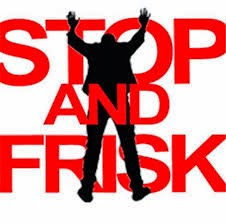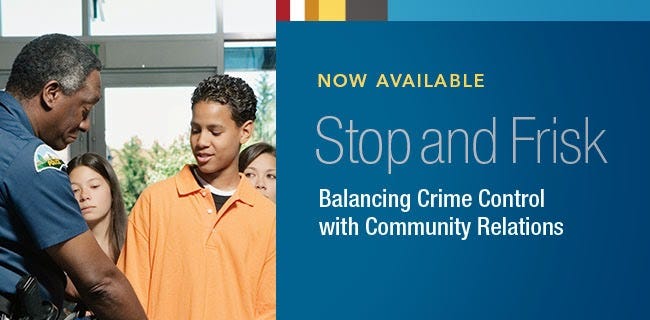COPS/DHS report claims 'Stop-And-Frisk' should be reviewed & refined for community policing

Supported by a DOJ/DHS grant, the Community Oriented Policing Services (COPS) report
(ironically called “Stop and Frisk: Balancing Crime Control with Community Relations."
COPS claims the report was assembled to help guide "law enforcement on how to conduct pedestrian stops in a manner that promotes crime control objectives while minimizing negative outcomes that can ultimately undermine police effectiveness."
The picture below, used by COPS or should I say DHS shows a black police officer searching a smiling black kid, while two white girls look on.

Nancy La Vigne of the Urban Institute's Justice Policy Center explained that the volume was based on a roundtable discussion held in 2011, when "stop, question and frisk" was a widely used, and hotly disputed, practice under then-New York City Police Commissioner Raymond Kelly, working for then-Mayor Michael Bloomberg.
New York Mayor Bill de Blasio campaiged against the practice, and the number of stop-and-frisk incidents has dropped dramatically under his police commissioner, William Bratton.
The Urban Institute report noted that stop-and-frisk can be done legally and can have an impact on crime, but "given the recent wave of protests, public backlash, court cases, and new laws attacking stop-and-frisk, this policing strategy is at a critical juncture."
The Urban Institute/DHS says 'stop-and-frisks' can be done legally! What a load of B.S. 'stop-and frisks' are illegal and in direct defiance of the 4th. Amendment.
The Urban Institute report said it is an open question whether the "widespread application of stop and frisk, which may target individuals based on the color of their skin and their presence on the street," is constitutional. (The de Blasio administration in New York City dropped an appeal of a federal judge's ruling that New York officers violated many citizens' rights as they practiced stop-and-frisk.)
The institute said that little research had been done on the impact of stop-and-frisk, but it is clear that the practice has "the potential for stop and frisk to influence attitudes toward the police in a negative manner." The report said that, "Individuals’ perceptions of the police may be particularly at risk in minority communities, which have a long history of tense relations with law enforcement."
http://www.thecrimereport.org/news/inside-criminal-justice/2014-10-stop-and-frisk-report
http://www.urban.org/UploadedPDF/413258-Stop-and-Frisk.pdf
http://www.cops.usdoj.gov/Default.asp?Item=2744
Study links Stop-And-Frisk to trauma & anxiety In young men:
A new study suggests that aggressive policing likely has an adverse effect on the mental health of young men -- particularly young men who are black or brown.
The study, released Thursday by the American Journal of Public Health, appears to show higher rates of feelings of stress, anxiety and trauma in young men who experienced multiple or intrusive stop and frisk encounters with police than among young men who had fewer or no such encounters.
"Our findings suggest that proactive policing tactics have the potential to negatively impact the relationship between the community and police, as well as the mental health and well-being of community members," Amanda Geller, a professor at New York University and lead author of the study, said in a statement.
The study surveyed more than 1,200 men between the ages of 18 and 26 in New York during a six-month period straddling 2012 and 2013. "Respondents reported high rates of police contact," the study says. "Although 80% of respondents reported being stopped 10 times or fewer, more than 5% of respondents reported being stopped more than 25 times, and 1% of respondents reported more than 100 stops."
Those who experienced the harshest and most intrusive police stops self-reported higher levels of trauma and stress, the study says, although even those who faced less intense encounters with police also reported symptoms.
"Most of the police encounters our respondents described didn't include an arrest or incarceration, yet they still reported associated mental health symptoms," Geller said in the statement. "This tells us that even the low levels of interaction that many urban residents experience may have consequences."
http://www.huffingtonpost.com/2014/10/17/stop-and-frisk_n_6003640.html
The following links show COPS/DHS disturbing relationship as they push for a national Stop & Frisk program.
Homeland Security training through community policing:
http://www.cops.usdoj.gov/Default.asp?Item=2487
Community Policing as the Primary Prevention Strategy for Homeland Security at the Local Law Enforcement Level:
http://www.hsaj.org/?fullarticle=1.1.4
Page 12 - Recommendations to DHS on Community Policing:
"DHS should work closely with the Office of Community Oriented Policing Services (COPS) at the Department of Justice (DOJ) to better incorporate the concept of community-oriented policing into programmatic and policy efforts associated with homeland security preparedness.
Increased resources should be made available (funding, training, technical assistance) to state and local authorities.
Establishing information-driven community-based violent crime reduction capabilities should be considered a preparedness priority by DHS.
Community-oriented policing costs should be included as an allowable expense within DHS grant programs."
https://www.dhs.gov/xlibrary/assets/hsac_cve_working_group_recommendations.pdf
Policing After 9/11: Community Policing in an Age of Homeland Security:


